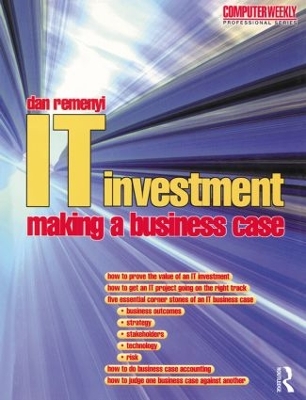Frequently not enough attention is given to producing a comprehensive business case or to producing an economic justification for an information systems investment. In fact many organizations are not clear as to what constitutes a sound business case and how to go about producing one. This Professional level book for the Computer Weekly Professional Series will show how to go about justification for I.T. spend.
This book is designed for all those who are involved in the decision to invest in information systems. This book is especially relevant to senior business executives, senior financial managers and IT executives.
Business consultants, computer and corporate advisors will also find the ideas and material addressed in this text of particular benefit as will anyone involved in corporate and strategic planning.
In addition, senior students such as those working towards their MBAs will find this book of use.
A business case is a statement or a series of statements that demonstrate the economic value of a particular intervention, a course of action or a specific investment. A business case is not simply a financial forecast of the hardware and software costs and the expected benefits. A business case for an information systems investment involves a comprehensive understanding of both the likely resources as well as the business drivers which will assist business managers improve their performance and thereby obtain a stream of benefits from the investment.
In general there are approximately six steps in producing a business case for an information systems investment.
1. Determine the high-level business outcomes that will be clearly and comprehensively expressed as a set of opportunities the organization can take advantage of, or problems that need to be rectified.
2. Identify the corporate critical success factors that will be supported or enhanced by the operation of the completed information systems project or investment.
3. Create a list of specific and detailed outcomes or benefits, their appropriate metrics, measuring methods and responsibility points that are represented by the stakeholders.
4. Quantify the contribution made by the outcomes, which requires associating numbers or benefit values with outcomes where this is possible.
5. Highlight the risks associated with the project.
Fundamental to this new approach to developing a business case for information systems investment is the fact that it incorporates much more than the financial numbers which are typically found in the standard approach to a feasibility study. This approach looks behind the financial numbers to the improvements in business performance which are facilitated by information systems and which are the real drivers of the benefits. Furthermore, this approach to developing a business case allows the organization to manage the process so that the required results are achieved.
- ISBN10 0750645040
- ISBN13 9780750645041
- Publish Date 1 September 1999
- Publish Status Active
- Publish Country GB
- Publisher Taylor & Francis Ltd
- Imprint Butterworth-Heinemann Ltd
- Format Paperback
- Pages 224
- Language English
